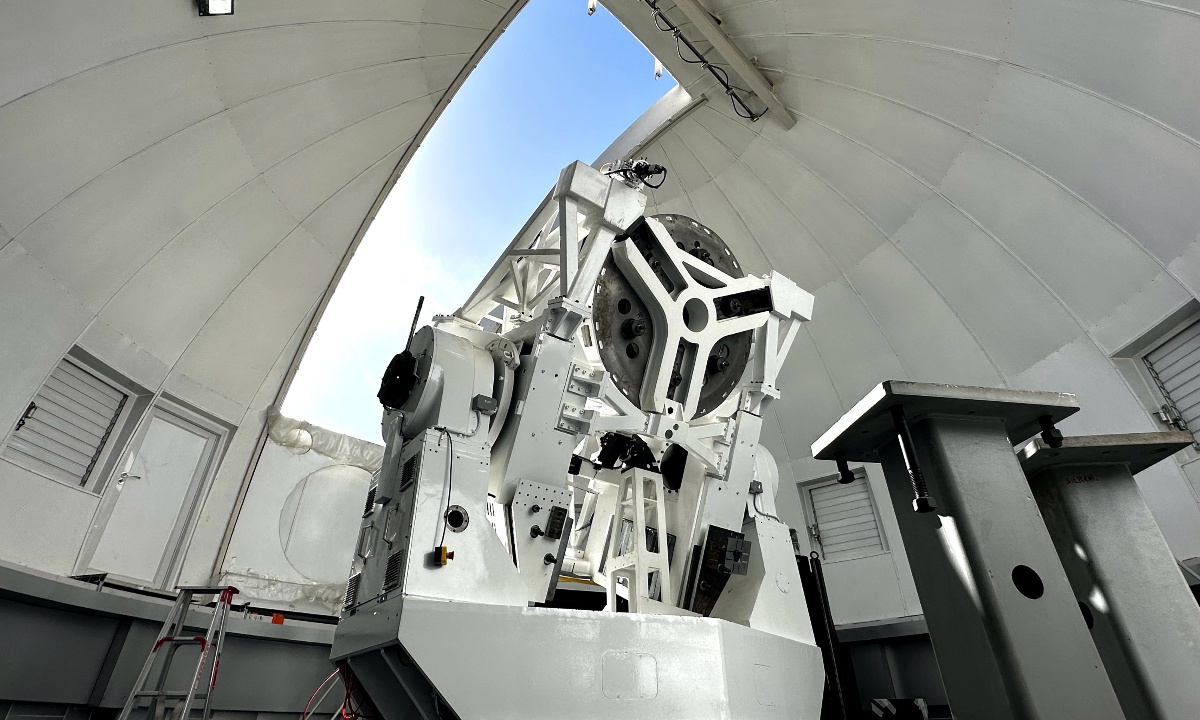There’s a new solar observing facility taking shape in China. It lies far up on a mountain near Mangya City in the Mongol and Tibetan autonomous prefecture of Qinghai. The telescope is reputed to be the world’s first mid-infrared telescope built for accurate measurements of the solar magnetic field.
The new observatory joins a collection of 35 astronomical telescopes—some already in construction and others in planning—arrayed across the grounds of the Lenghu Astronomical Observation base. That’s a reserve located some 4000 meters up in the Quighainan Mountains. It’s run by the National Astronomical Observatories of China and the Chinese Academy of Sciences.

Scientists refer to the Lenghu base as “one of the most Mars-like places on Earth”. That’s largely due to its dry climate, number of sunny days, and clear atmospheric transparency. Those conditions make it a perfect location to do mid-infrared solar observations. The new state-of-the-art facility is now in testing. It should start trial observations within the year. According to Wang Dongguang, chief engineer from the Huairou Solar Observing Station, this telescope is expected to fill an important niche in the world’s solar observatories.
Infrared Challenges
Doing astronomy observations of any kind in the mid-infrared range raises challenges. They require perfect conditions for the equipment to gather the light needed. According to senior engineer Feng Zhiwei, the team has met several key goals. “Scientists solved the challenge of high ambient noises and degraded detector performance they have encountered in solar observations within this range of the infrared band,” Feng pointed out. The solution lies with domestically made detector chips being installed and tested.
Feng also noted that the system is mainly used for monochromatic imaging observations in the infrared band between 8 and 10 microns. This is important when investigating the mechanism of mass and energy transfer during violent eruptions.
Solar Activity in the Infrared
The infrared range of the electromagnetic spectrum is quite useful for studies of the Sun. Some wavelengths in that range are relatively easy to observe from the ground. Those are in the so-called “infrared atmospheric window” that admits infrared light roughly between 8 and 14 microns. Depending on conditions, light passes through our atmosphere without getting absorbed by the atmospheric gases and water vapor.
However, things get tougher when astronomers want to look at wavelengths beyond that window. The atmosphere absorbs other ranges of infrared light, and it also emits its own infrared. That makes observations tougher to get. To obtain good infrared “seeing”, facilities need to be located near the summits of mountains in dry climates. The telescopes in Hawai’i and Chile and the mountains of China are good examples of facilities that take advantage of high-altitude conditions.
According to scientists from the Chinese Academy of Sciences, this new facility will provide a more accurate study of the Sun’s magnetic field. It will also furnish mid-infrared imaging and spectral observation data. They hope it will achieve major breakthroughs in solar physics with their in-depth studies of the solar magnetic field. The science teams plan to use it to study the mechanism of the generation, accumulation, triggering, and energy release of magnetic energy. Its long-term observations should provide insight into the transfer of matter and energy during violent eruptions such as flares.
Adding in a New Solar Facility
China’s new mid-infrared-enabled solar observatory joins a worldwide collection of telescopes aimed at our star. There’s the newly opened Daniel K. Inouye facility in Hawai’i, which is doing science aimed at understanding the fundamental processes and activities in the Sun. Of course, there’s a slew of orbiting and space-based solar telescopes out there. NASA’s Parker Solar Probe dances close to the Sun during its approaches. Other facilities, such as China’s ASO-S solar observatory, the NASA STEREO mission, the NASA/ESA Solar and Heliospheric Observatory, Solar Dynamics Observatory, and ESA’s Solar Observer, are giving long-term looks at the Sun from various orbits, and in many cases, provide early warning of solar activity.
Wang stated that the AIMS telescope is not only innovative in its scientific goals by global standards but also provides other breakthroughs. The research and development of the telescope promote the continued research into infrared spectrum and infrared polarization measurement technology in China.
Scientists at CAS aim to have it be among the pre-eminent astronomy locations in the world and they want to protect its access to the sky. The astronomy “preserve” will have environmental protections from pollution and other interference. Among the 35 telescopes planned, four are now in use. Another 28 have completed the construction of observation towers and dome installation. The rest are in the research and development stages over the next year.
For More Information
China-made world’s 1st mid-infrared solar observation telescope nearing trial stage
World-class Astronomical Observation Base Takes Shape in Qinghai Province
The National Solar Observatory
Parker Solar Probe

